Dracaena breeding methods at home
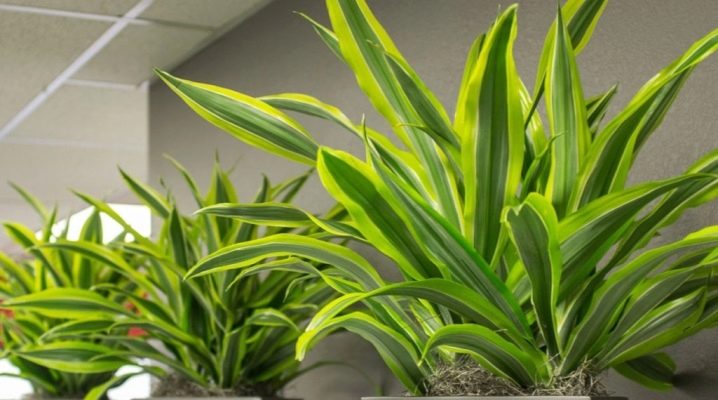
Dracaena is a very popular ornamental plant that is grown both in a room or office and outdoors in a subtropical climate. It can grow up to 90 centimeters indoors and, with proper care, takes on the appearance of a bushy tree. Leaves with an attractive gloss can create a wide crown, but this requires proper care of the dragon tree.
Favorable conditions
The plant grows well at home, you only need to observe the temperature, humidity, and monitor the lighting. Depending on how much attention is paid by a person, the healthy growth of dracaena also depends.


Temperature and lighting
Most dracaena species thrive and stretch upward in dense foliage in rooms with bright but indirect light. While this is preferred, the plant may thrive in less light, but the leaves will be thinner. Once the rooted stalk is acclimated to the amount of light in the room, the foliage will become a darker, more attractive green. Avoid exposure to direct sunlight as dark brown spots may appear on foliage.
Filtered indoor light, such as through a curtain on a sunny window, or creating partial shade is ideal.

Dracaena prefers temperatures in the 65-78 range. Temperatures can be up to ten degrees lower at night, but cold drafts should be avoided. The plant should be kept away from heating or cooling appliances.
The leaves of any dracaena will eventually pick up dust, so a person is required to regularly clean them with a damp cloth. If the stems become too long and bare, they are pruned at the correct height, where new shoots will soon appear.
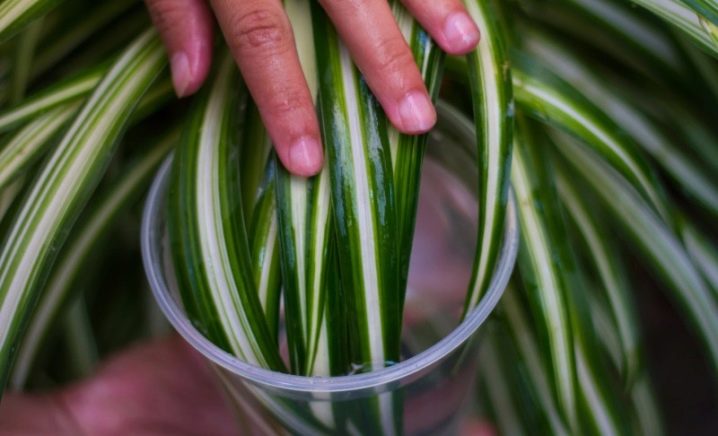
The soil
All types of dracaena are great for home and office environments, but sometimes suffer from a lack of moisture. It is required for planting to choose a container that is no more than a third larger than the root ball of the plant. One third of it is filled with a soil mixture that is designed so that midges develop in it less. This soil does not contain compost or bark, which can be used by insects as shelter.
It is worth saying that mushroom midges are a common problem when growing dracaena. A quality blend is also easily hydrated thanks to the coconut coir it contains.


The plant is placed in a container and positioned so that the top of the root ball is approximately 2.5 cm below the top edge of the container. Thus, it will be convenient to water the plant and water will not spill over the top onto the windowsill.
Humidity
If the room is very dry, the tips of the leaves begin to brown. In this case, you will need to spray them with water every few days, or place the pots on trays filled with pebbles and water them well. As the water evaporates, the humidity in the air will increase.
Dracaena require less water than most houseplants. However, foliage needs to be moistened, as well as keeping the soil slightly moist, but there must be good drainage in the container design. Always allow the soil to dry before the next watering.
It is impossible for moisture to linger in the container, otherwise the root system will rot.

Dropped or yellowed leaves always indicate over-watering or poor drainage, but you shouldn't worry about this as the problem can be easily fixed. Dracaena is accustomed to throwing off leaves in order to grow new ones, she does not suffer from this.
Natural indoor humidity is good, but this houseplant prefers a higher value because it is native to rainforest. You can simplify the task and improve the humidity using a special humidifier, or simply place the dracaena on a tray with pebbles so that the water flows there when watering, and then evaporates.

This plant is sensitive to fluoride, which can be found in tap water, so it is best to use filtered, filtered water. Leaves with dark brown and dead patches with yellow edges may indicate fluoride toxicity.
The right time
The best time for transplanting is when the dracaena has grown a lot and it's time to grow a new specimen, or you need to give an attractive decorative look to the old plant, but you don't want to throw out the cuttings.
Regular pruning also does not always solve the issue of creating an attractive appearance of dracaena, the stems become very long. If you want to make the plant compact, then you need to cut them off. In this case, you can propagate the plant with stems.


It is worth saying that a young dracaena is a bush up to a year, at two years old she is already considered an adult, capable of withstanding pruning.
Reproduction methods
An indoor flower can be propagated in various ways, but the simplest is to take a cut from the stem and then stick it tightly into the germination mixture, ensuring then high-quality watering. Liquid fertilization may be required when foliage begins to appear. Other breeding methods for dracaena include aerial layering and root cuttings. To choose the method that suits you, you need to study each of them in more detail.


Apical cuttings
A mature plant can be branched out by simply rooting the top. This will help return the dracaena to its former attractiveness, and at the same time get new indoor flowers. To carry out the procedure, you will need a sharp and clean knife, which is used to cut off the top with leaves and a small stem.

From the last leaf, the trunk should be 15 to 18 centimeters in size. All shoots from the cut area are removed, including old leaves, and the seedling is left to dry out a little.
At home, this process takes root without much effort on the part of a person, you just need to take water, add a growth stimulator and a small amount of charcoal to it. The best mixture for germination will be soil with the addition of sand and a small amount of peat. It is advisable to steam it before planting.


At the germination stage, it will be necessary to create greenhouse conditions for the plant, so the stem is covered and the level of humidity inside is regulated. If there is too much moisture, you can sometimes ventilate the greenhouse for 15 minutes. Excessively wet soil has a bad effect on the process of root emergence, since in this case the shoot simply rots. The room temperature should remain at 20-22 degrees.
Spraying with simple but settled water, which should at least be at room temperature, has a very favorable effect on the development of seedlings.
The spray gun can also be used as a means with which the first dressings are introduced.

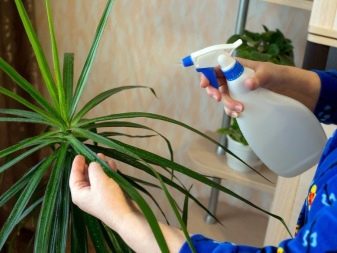
Stem cuttings
The practice of propagation by stem cuttings is useful for rejuvenating overgrown houseplants such as dracaena. At home, such a flower is striking in its capabilities. At the stage of active growth, it produces rosettes of belt-like leaves at the end of each shoot.Older leaves gradually fade and fall, leaving bare stems at the base. Each part of the shoot has the ability to develop roots from its base, while new ones will appear through the tip and to the sides.



To graft with this reliable method, you will need:
- process;
- gardening scissors;
- a can of water;
- flower pots;
- multipurpose compost.




The step-by-step process is as follows.
- Cut the rod into pieces of 20-30 centimeters. It is imperative to note where the end and the upper part are, because if the shoot is placed incorrectly in the ground, then the roots will not form.
- Place the base of each section in a jar of water and place it in a warm room. Replenish water regularly.
- From time to time, check for white nodules around the base of the stem, which will develop into long roots a little later.
- Look for bumps that arise and push through the bark. The stems are inserted into the soil to develop shoots and form new bushy plants.
- Once the stem sections are well rooted, each is transferred to a small container, watered regularly and fed with fertilizer. Gradually, you can change the container to a more spacious one.

Air layering
When a young plant is still in the room, it is impossible to propagate it by cuttings, since you can cause irreparable harm to it. In this case, the best solution would be to use air layouts.

If you look closely at the place where the old leaves were attached, which eventually fall off, it is difficult not to notice the places suitable for the formation of roots. Here you need to make a small transverse incision somewhere to the middle of the trunk and insert a toothpick there so that it does not drag on over time.
Sphagnum is wound around, everything is closed with a bag, but the moss under the film should not dry out, so from time to time it is required to moisten it with a spray bottle. When a root appears, which begins to sprout through the established structure, the seedling is cut off, since it is completely ready for independent life in a new pot of soil. Sometimes new shoots appear at this place, which will later become part of the trunk. The cut off branch should be placed in a greenhouse or a glass jar should be placed on top of it so that it better endures the acclimatization process.

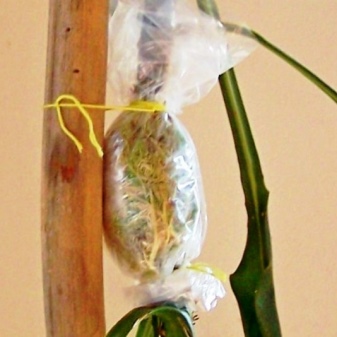
It should be noted that such a reproduction method is much more complicated, but if everything is done correctly, then the resulting seedling develops perfectly on its own and is completely similar to the mother plant, while at first it demonstrates accelerated growth.
Seeds
Dracaena can please with a large beautiful dome of green leaves with dense branches piercing the underside of the canopy, resembling fingers. Although it is difficult to obtain its seeds, there is still a breeding method using such planting material, as well as special requirements for germination and sowing for successful seedlings.
Early spring is the time to start breeding in this way. Experts advise to pay attention to several main points:
- you need to purchase seeds from a supplier that specializes in growing plants in greenhouses;
- keep the material in water at room temperature for 3 to 5 days to increase the likelihood of germination;
- it is important to make sure that the container has a drain hole in the bottom.


The soil for planting must be moistened so that it is slightly moist, but not too much. Then dracaena seeds are poured onto the surface. They cannot be pressed into the ground strongly, you just need to cover them slightly. Place the pots in a warm place. Dracaena germinates from seeds at a temperature of 20-27 degrees.
In the next step, cover the plants with a bag to create a greenhouse. Place the container on a window under bright but indirect light. Avoid sunny windowsills, as the direct rays are too intense and can dry out the soil.
Water is added as needed.To preserve the seeds, the mixture must remain slightly damp. If the grower has noticed that water is dripping down the inside, it is worth either to loosen the greenhouse or make several holes in it. The seeds can rot if the conditions are too humid.
Remove the polyethylene when shoots appear. On average, the first results should appear in 4-6 weeks. Transplanting seedlings into separate pots requires the use of standard potting soil, and the seedlings should have two leaves.


It is worth knowing that the use of warm water first causes the growth of the embryo inside the seed. In their natural environment, they are protected from direct sunlight by domed branches, but are kept warm by the hot surrounding climate. Change the water daily during the soaking period. The water gradually gets cooler during the day, so you need to keep it at a certain temperature or topping it up.
Seedling care
Dracaena will add variety to your home plant collection, but it needs to be properly planted to create attractive new trees. There are several popular species of this plant, including "Bamboo", which is actually not bamboo at all.

Dracaena Fragrance has thick brown stems and green leaves, often with a yellow stripe down the middle, so it looks like corn. Dremensis is a robust variety with thinner leaves.
You can also consider the dracaena "Marginata", sometimes called the "dragon tree" as it has thin brown stems with tufts of thorny leaves at the top.


All these varieties are easy to care for, you just need to plant them correctly. Follow the advice of professional growers and use liquid or slow-release fertilizers for the seedlings. Iron deficiency can lead to yellowing of the leaves, so this problem should be addressed when the first symptoms appear.
It must be said that dracaena grows well in any type of pots that have drainage holes in the bottom. Standard soil for indoor tropical plants maintains sufficient moisture without becoming soggy. Mixtures usually contain loam, peat moss, vermiculite or perlite. The tray placed under the container is designed to collect excess water and must be emptied after each watering.
The size of the pot varies according to the size of the plant.

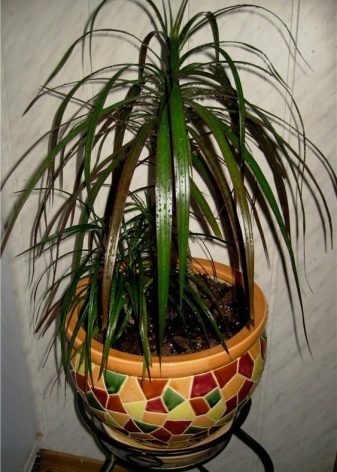
Dracaena requires that the root node be covered with soil, otherwise it begins to root from the drainage holes. A transplant into a larger pot is required every 2-3 years at the end of winter. The new container should be 20 centimeters wider.
Dracaena rarely requires heavy pruning. She produces canes that can be cut to the desired height if the plant begins to overgrow. The procedure is usually carried out in the spring, but it can be done at any time when the dracaena is actively growing. Leaves turn yellow and die over time; it is also allowed to remove them at any time in order to improve the appearance of the tree.

Most species of dracaena tolerate a fairly low level of light, but increased growth is immediately noted if you move the pot with it to a sunny place. Choosing a container costs no more than a third more than a root ball.
For irrigation, it is worth using well or rain water, if possible, but if it is not there, then it is advisable to purchase distilled water in order to keep the plant hydrated.

A month after planting, you can begin to make top dressing. In a few weeks, it will be noticeable how the dracaena has grown sharply. Be sure to follow the directions on the packaging and observe the proportions in accordance with the manufacturer's requirements. Reduce the frequency of feeding during the colder months.
Dracaena should be fertilized with a water-soluble fertilizer of nitrogen, phosphorus and potassium in a ratio of 3: 1: 2, as well as zinc, sodium, manganese, copper and iron.It is used every 4 weeks in the spring and summer months, when active growth is observed. In the autumn-winter period, the plants do not need feeding.

Do not apply fertilizer to dracaena for one month after the plant returns home from the nursery. She needs time to acclimatize in a new place. Feeding too early after relocation puts additional stress. If the owners move and take a tree with them, then they reduce the amount of fertilizer applied by 50% a month before the move date and do not fertilize the first month in the new house. Be sure to maintain the pH of the soil in the range of 6 to 6.5. Another indicator will prevent nutrients from being absorbed normally, leading to damage to the leaves.

Properly fed dracaena will show vigorous growth of leaves and stems during the warmer months. If not, then she is not getting enough food. In this case, fertilize it every two weeks until a positive result is noticeable, but you should not overdo it either. If there is too much fertilization, then the tips of the leaves and fields begin to turn brown or yellow.
In addition to feeding, dracaena need the right environment. They need a bright spot that is not in direct sunlight, such as a north-facing window. Humidity should be between 60 and 100%.
When the dracaena becomes too wide or too tall, pruning is done. In this case, they simply cut off the tops, bringing the tree to the desired height, because soon they will sprout again. You can root the trimmed tops to get even more plants.

Fortunately, indoor disease or pest infestation is a rare problem for dracaena. The biggest problem usually arises from improper watering, when there is too much or too little. Spider mites can infect her. Root rot usually occurs when the soil is constantly flooded with water or there is no drainage, which was mentioned above.
When the humidity gets too low or during the winter months, the tips of the leaves can turn brown. In this case, you can simply use a spray bottle or humidifier. If dracaena suffers from sudden loss of leaves, a number of reasons can contribute to this:
- temperature change;
- too much water;
- poor drainage;
- insect damage.


Possible difficulties
Dracaena most often grows indoors and decorates it like a houseplant. The potential problems associated with growing it indoors can be avoided by following simple precautions.
This plant grows best in temperatures between 65 and 90 degrees Fahrenheit. It will feel bad if the temperature drops below 65 degrees. One week will be enough for permanent damage. If the temperature drops to 32 degrees Fahrenheit, traces of rotting appear on the leaves.
White or yellow spots will form on the plant if grown in low temperatures and bright light. Growth is best observed with 63-73% shadow. Leaves with white or yellow stripes, called variegated, do not contain the chlorophyll needed for photosynthesis. Dracaena "Maryinata Tricolor" has a thin yellow stripe on each leaf, which makes it difficult to grow indoors except in very bright rooms.


Excess soluble salts, fluorides, or boron will cause the dracaena to suffer discoloration or decay at the tips. To prevent excess salts, fertilizer is applied once a month from nitrogen, phosphorus and potassium. Low humidity, bright light, high temperatures and wind can lead to fluoride build-up. In this case, limestone or wood ash is added. To raise the pH of the soil, granular sulfur is used. It is better not to use fertilizers containing superphosphate or phosphorus-containing fluorides. Boron is essential for growth, but in this particular case it is better not to use it.
If the plant is allowed to stand in a damp pot, fungal or bacterial rot can develop. Carefully monitor the moisture content of the soil when growing dracaena in a large plastic or glazed ceramic pot.

For information on how you can propagate dracaena, see the next video.































The comment was sent successfully.